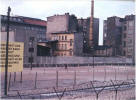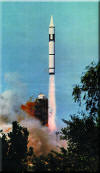|
USII.7c Cold War,
Korea, Vietnam, Collapse of Communism in Europe |
The student will demonstrate knowledge of the economic, social, and
political transformation of the United States and the world between the
end of World War II and the present by
c) identifying the role of America’s military and veterans in defending
freedom during the Cold War, including the wars in Korea and Vietnam, the
Cuban missile crisis, the collapse of communism in Europe, and the rise of
new challenges. |
|
How and why did the Cold War begin? |
|
The United States and the Soviet Union
emerged from World War II as world powers, triggering a rivalry over
ideology and national security. |
Origins of the Cold War
• Differences in goals and ideologies between the United States and the
Soviet Union (the two superpowers)—The United States was democratic and
capitalist; the Soviet Union was dictatorial and communist.
• The Soviet
Union’s domination over Eastern European countries
• American policy of containment (to stop the spread of communism)
• North Atlantic Treaty Organization (NATO) versus Warsaw Pact
 East
Germany behind the Berlin Wall East
Germany behind the Berlin Wall
Cold War Museum |
Terms to know
• Cold War: State of tension between the United States and the Soviet
Union without actual fighting that divided the world into two camps
 Russia
will continue to present the largest ballistic missile threat to the
United States. Russia retains thousands of nuclear warheads on ICBMs and
most of these missiles are maintained on alert, capable of being
launched within minutes of receiving a launch order. Russia
will continue to present the largest ballistic missile threat to the
United States. Russia retains thousands of nuclear warheads on ICBMs and
most of these missiles are maintained on alert, capable of being
launched within minutes of receiving a launch order.
CSS-4 test launch
Cold War Museum
|
|
What have been the major conflicts
and confrontations involving America in the post-World War II era? |
How did Cold War tensions cause divisiveness at home?
|
|
Since World War II, the United States
has been directly involved in various conflicts that reflected the
divisions created by Cold War tensions and hostilities. |
The
tension between the free world and the communist world caused divisiveness
at home and abroad. |
Major conflicts in the post-World War
II era
• South Korea and the United States resisted
Chinese and North Korean aggression. The conflict ended in a stalemate.
• The Cuban Missile Crisis occurred when the
Soviet Union placed missiles in Cuba. The Soviets removed the missiles in
response to a U.S. blockade. |
• The United States intervened to stop the spread of
communism into South Vietnam (Domino Theory).
Americans were divided over whether the United States should be involved
militarily in Vietnam. The conflict ended in a cease-fire agreement in
which U.S. troops withdrew. |
|
How did communism collapse in
Europe? |
How were the challenges after the
Cold War different from earlier challenges? |
|
The Cold War was the central
organizing principle in foreign affairs for 40 years. |
Collapse of Communism in Europe
• Breakup of the Soviet Union into independent countries
• Destruction of Berlin Wall |
New challenges
• Role of U.S. military intervention
• Environmental challenges
• Global issues, including trade, jobs, diseases |
 • With rationing of consumer goods over, business converted from
production of war materials to consumer goods.
• With rationing of consumer goods over, business converted from
production of war materials to consumer goods. • As economic prosperity continued and technology boomed, the next
generation of women re-entered the labor force in large numbers.
• As economic prosperity continued and technology boomed, the next
generation of women re-entered the labor force in large numbers.
